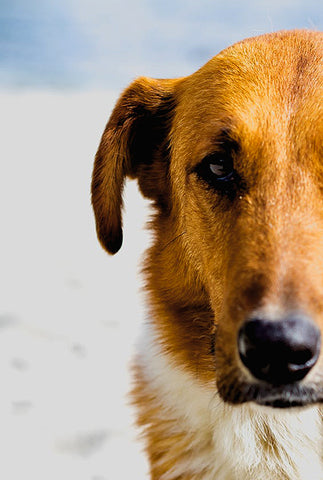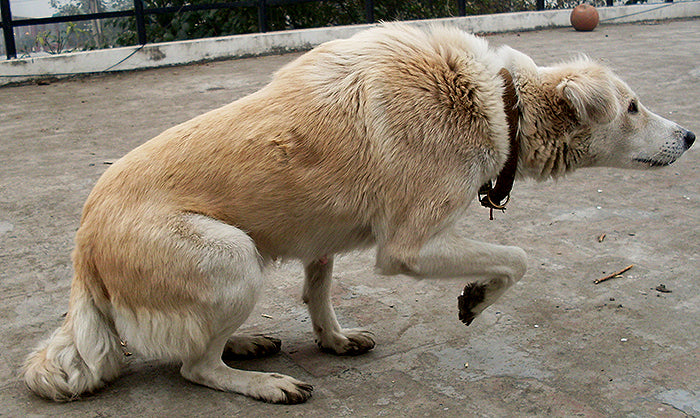Speaking Your Dog's Language

The Art of Signals
From the tip of their tongue to the tip of their tail, dogs use their entire body to let you know how they are feeling; the trick is to learn how to understand what they are trying to tell you. Dog body language is all about communication. They may not be able to say “Timmy fell down a well,” but they are constantly giving signals to try and direct your behavior and let you know what they need.
We communicate using a number of signals including the sounds of our voice and facial expressions, but animals can sense even our subconscious thoughts because we portray them in ways we are unaware of. Dogs are sensitive to our energies, and we can learn how to become more sensitive to theirs.
Canine Speak
Dogs have been domesticated for over 15,000 years; however, they still hold on to their primal understandings of communication. Dogs use their bodies and vocal gestures to tell us what they are thinking.
Vocal expressions are often used only when dogs feel their body language has not communicated the message. Dogs bark in times of happiness or anxiety, but often will change the pitch and frequency to communicate different things.
Some breeds are more 'talkative' than others and will grumble, whine, and 'talk' in casual settings. Bully breeds are especially known for 'speaking' as they move around the house!
All About The Approach
Since we have more options for communication, it's important for humans to take our roles in advocating for how our dog would like to be treated by other people (and animals!).
In the canine world direct eye contact is a challenge and you rarely see two dogs staring each other down unless they are challenging each other. Humans find eye contact reassuring and friendly so we often approach dogs by looking them directly in the face.

A submissive dog will break eye contact and often look down. A more dominant dog will stare back and may begin to growl or snarl if you continue approaching. “His bark is worse than his bite” may be an old adage, but it’s not one that should be put to the test!
Some dogs are more social than others. Here are a few warning signs to look for to see if your dog is experiencing stress in social situations:
- Excessive yawning
- Licking their chops when no food is present
- Freezing for a few seconds before reacting. This can be the moment of adrenaline before a 'fight or flight' response kicks in
- 'Whale Eye' – the dog turns his head away but keeps looking at the perceived threat, showing the whites of his eyes
- Head turn
- Furrowed brow, curved eyebrows – caused by facial tension
- Tense jaw – the mouth is closed, and the dog is preparing for action
- Low tail
- Shaking – caused by adrenaline release
- Drooling – stress can also cause excessive salivation
- Lack of focus – moving around or away from the source of stress
- Piloerection – the hair on a dog’s neck and spine stands on end (like human goose bumps), making the dog appear bigger while releasing odor from the glands contained in the dog’s hair follicles.
A well-socialized dog should be able to meet new and respectful strangers without exhibiting any of these stress signals.
Sometimes humans use our methods of showing affection to each other with dogs, and most dogs do not respond well to feeling trapped or dominated. Simple actions like hugging a dog, patting them on the head, or greeting them while standing over them can send all of the wrong signals.
Always bend down to a dogs level when greeting them. Let them investigate you, and do not raise your hand in their face or above their head. Instead, try the side approach and reach around for their flank once you get the go ahead.
Who's A Happy Dog?

There is nothing better than a wagging tail greeting you when you come home. Their body is relaxed, mouths slightly open, and their eyes are bright and eager.
Other signs of a relaxed and happy dog include:
- Play bow – this signal invites play and tells others that whatever action comes next is still just play
- Turning over, inviting belly rub – showing trust and enjoying social contact
- Relaxed facial expression
- Squinty or blinking eyes
- Tail wagging fast, either side to side or in a round motion like a helicopter
- Wiggling backside
Wag This Way
A wagging tail is often a sign of a happy dog, but different motions can indicate a range of emotions.
- A confident dog will hold its tail in the air.
- Tail between their legs or held low signals nervousness, a lack of confidence, or fear.
- Slow wags can indicate that the dog is assessing the situation.
- An extended or curved tail indicates tension. Often seen before defensive action is taken.
- Helicopter wags and a wiggling bottom demonstrate joy and excitement.
- Dogs can be specific enough to wag their tails slightly more to the right with people they know, and to the left in unfamiliar situations. It can be easy to miss things that subtle!
Clear Eyes, Open Hearts, Can't Lose

Dogs constantly check in with us to let us know how they're feeling. Learning their signals can help you understand them better and become even more attuned to their needs!
Take new situations slowly and be patient when working with your animal. You'll be a body language expert in no time!




